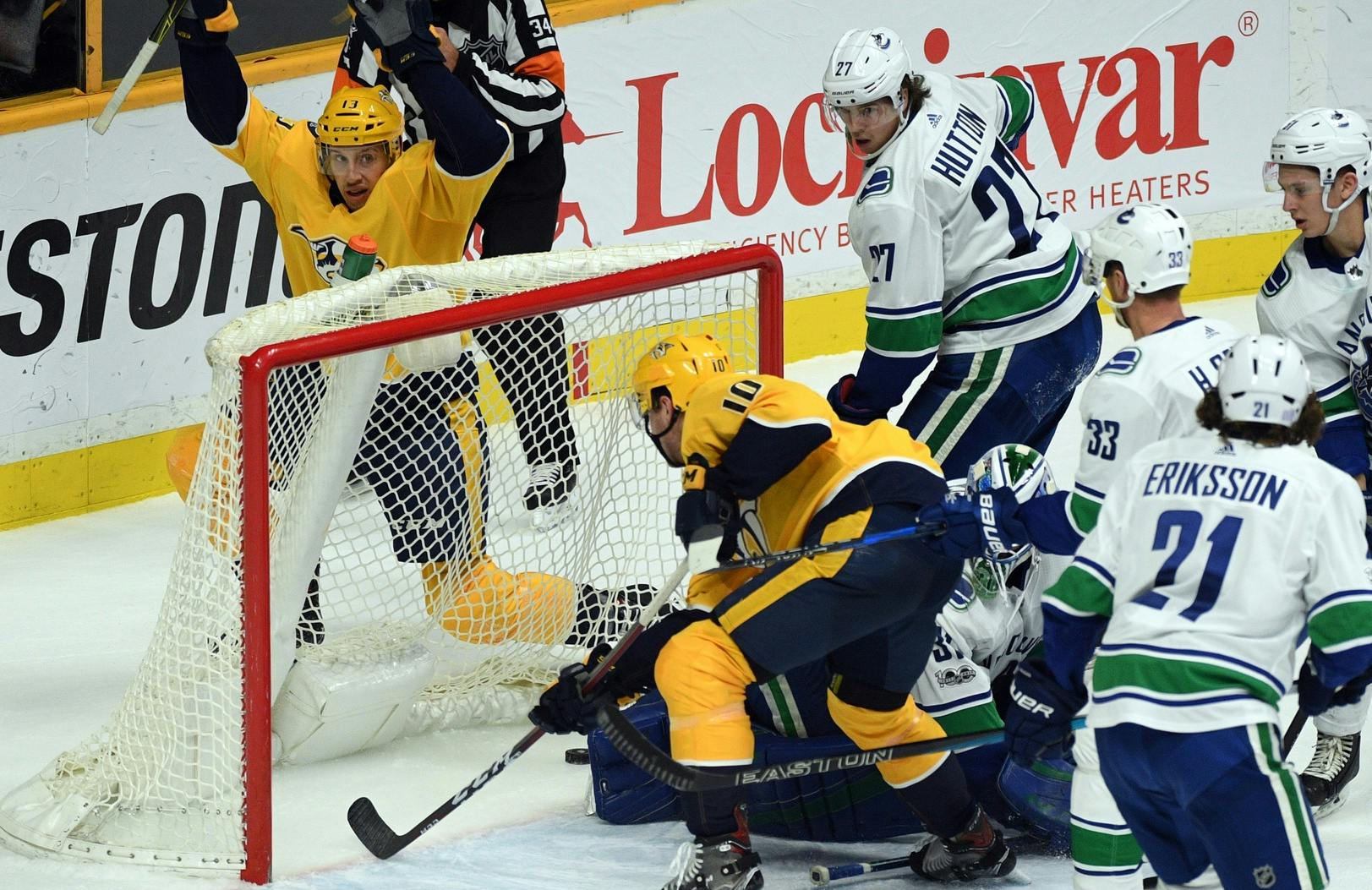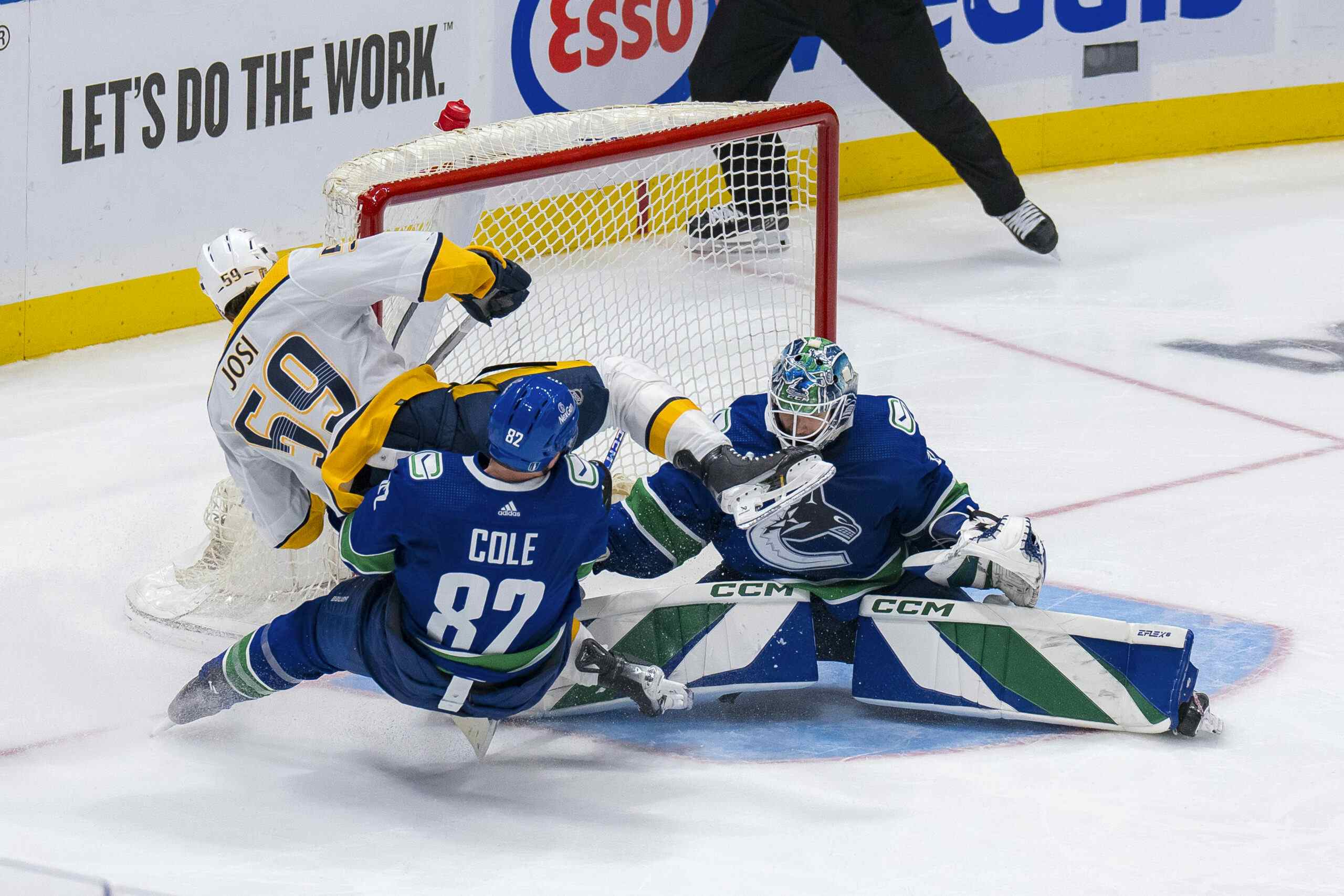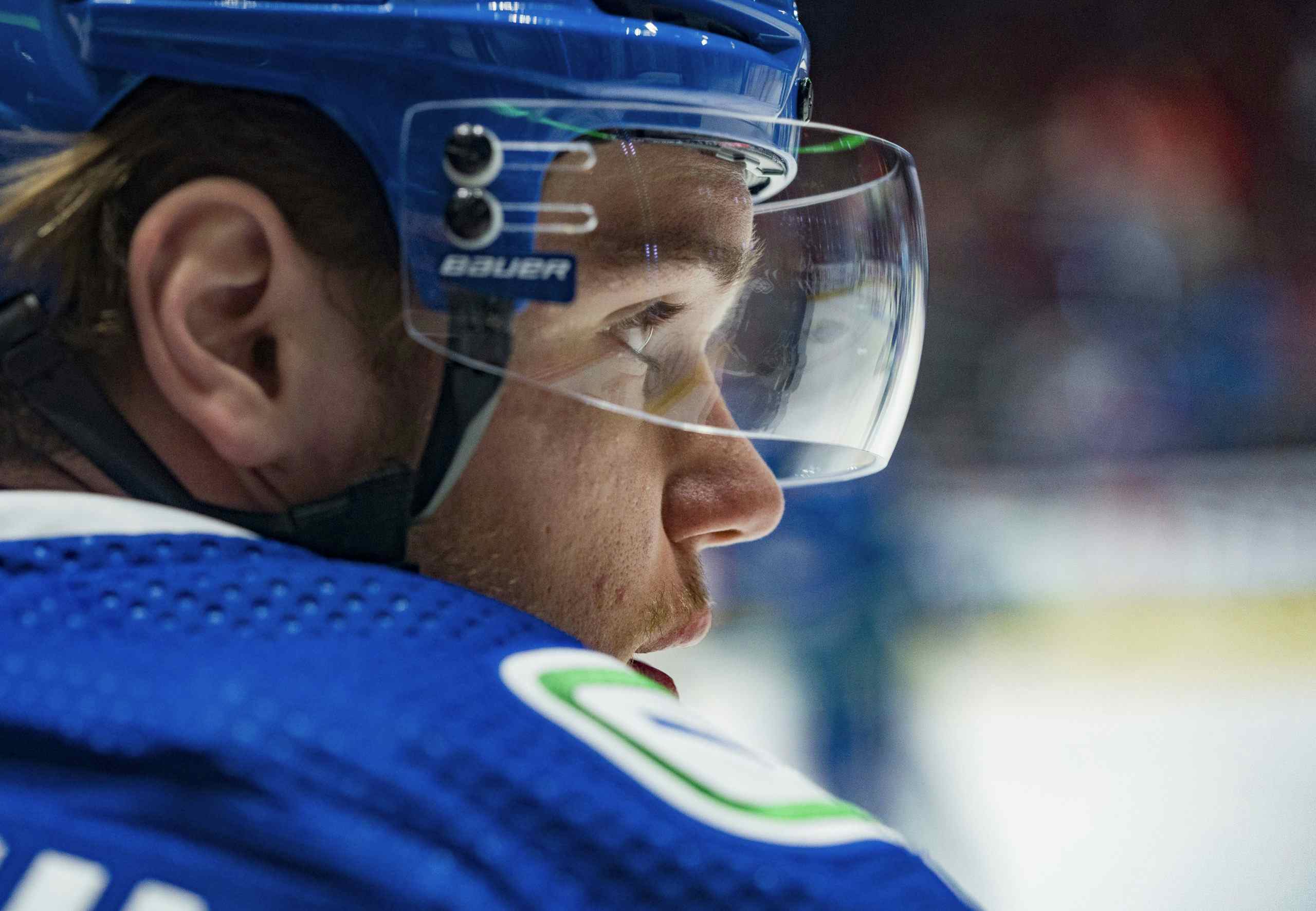The Jim Benning Five-Year Rewind: 2015 Free Agent Frenzy, other offseason transactions, and the Frankie Corrado Incident

Last outing, we promised not to take another nine-month break between editions of the Jim Benning Five-Year Rewind, and today we are here to deliver.
If you’ve missed previous issues of this column, here’s the explainer we included last time around:
“GM Jim Benning just completed his sixth season as GM of the Vancouver Canucks, and that’s mighty convenient for our purposes, because an old sports maxim claims that you can’t truly judge a manager’s transactions until at least five years has passed. In the Five-Year Rewind, we’re trying to take a look at each of the moves that have occurred during Benning’s tenure as they pass that five-year threshold, with the hopes that a half-decade of hindsight will allow us to more accurately assess them.
Also, since draft reviews are frequent and commonplace, we’re going to avoid that topic and just stick to the signings, trades, and waiver transactions.”
Last time, we looked at Benning’s moves during the 2015 Trade Deadline and in the early offseason leading up to that year’s Free Agent Frenzy, including the trades of Eddie Lack and Kevin Bieksa.
Today, we’re moving on to the Frenzy, and then covering everything else that happened in the leadup to the 2015/16 season, Benning’s second with the Canucks and the first in which he truly started putting his stamp on the team — for better and for worse.
Free Agent Frenzy 2015
July 1, 2015
Signing
Matt Bartkowski
One year @ $1.75 million per
We start our rewind with the player who earned the title of “Tank Commander” during their single-season tenure in Vancouver. Bartkowski provided a smidge more offence than the typical depth defender, but his defensive gaffes and miscues soon became legendary. At his salary, it could be argued that he was slightly overpaid, but it’s not like it was a consequential contract, and at least his mom was a lot of fun.
Ultimately, having Bartkowski be your high-profile UFA signing for the summer isn’t great for a team that was allegedly still trying to compete. Thinking long-term, however, he’s also a signing that didn’t turn into an anchor, may have provided enough offensive skill to aid in the development of young forwards just a little, and contributed to the Canucks earning another lottery pick. That ain’t bad.
| Vancouver Canucks Stats | Games | Goals | Assists | Points |
| Matt Bartkowski | 80 | 6 | 12 | 18 |
Signing
Richard Bachman
One year @ $575K per
Bachman only got into seven total NHL games during his five years with the organization, but that doesn’t mean this was a signing without value. Though he didn’t share the crease with Jacob Markstrom for more than a few games, Bachman proved a valued mentor and competent backup to Thatcher Demko — never too good to keep Demko out of the net for long, but never too bad to make the young netminder feel like the entire team’s fortunes rested on his shoulders.
In many ways, Bachman was an ideal fourth-string goalie, and that’s why he earned four more years with the franchise after this one.
Signing
Taylor Fedun
One year @ $600K per
Fedun performed well in his single season with the Comets, and he also managed to post one assist in his one-and-only game with the Canucks. Overall, he was never intended to be anything more than AHL depth — but an extreme optimist might posit that he was a very well-selected depth piece, given that he’s still kicking around the NHL and just played 11 playoff games for the Stanley Cup runner-up Stars.
Trade
To Montreal:
Zack Kassian
5th Round Pick in 2016 (Casey Staum)
To Vancouver:
Brandon Prust
Now we get into the less-encouraging stuff. Yes, there were definitely some mitigating factors at play here, primarily the personal issues that would eventually prevent Kassian from ever suiting up for the Oilers. But to target Prust of all people, a player with limited skill who proved a toxic element in the dressing room — and to actually add a draft pick to seal the deal — is a real head-scratcher.
Sure, Prust speared Brad Marchand in the groin, and everyone loved that. He also threw a hissy fit when Jake Virtanen was dressed ahead of him for a game against the Rangers — a team he had left four years prior, against whom he’d already played countless times. Eventually, he had to be sent down to Utica. There’s a reason Prust was in the DEL by the very next season, and it’s not because he was a worthy trade target.
Clearly, Kassian wasn’t working out in Vancouver and a move elsewhere was in his best interests. But he still had a lot of NHL-level skill to offer, something that Edmonton discovered when they gave him a shot at redemption in 2015.
Even if you accept that Kassian had to go, he should have returned more than Prust, who proved a negative asset. Instead, Jim Benning paid extra.
| Post-Trade NHL Stats | Games | Goals | Assists | Points |
| Zack Kassian | 327 | 47 | 64 | 111 |
| Brandon Prust | 35 | 1 | 6 | 7 |
July 3, 2015
Signing
Blair Jones
One year @ $600K per
Jones never suited up for the Canucks, and only played 36 games with the Comets before being loaned to the Charlotte Checkers. He joined Prust in the DEL the next season. It was amusing to see Vancouver sign one-tenth of that infamous opening faceoff line brawl against Calgary, but that’s about all that can be said about this signing. Standard depth.
Let Go:
Brad Richardson, Shawn Matthias, Ryan Stanton, Cal O’Reilly, Bobby Sanguinetti
O’Reilly and Sanguinetti were AHL depth players destined to move on. Matthias signed in Toronto for a pay raise he did not really live up to. Stanton only played one single NHL game after leaving Vancouver, and he’s become an AHL mainstay. The Canucks did not miss any of those players.
But let’s take a minute to talk about the departure of Brad Richardson.
Richardson did receive a small pay bump and solid term from the Coyotes in order to entice him to leave Vancouver, and he may not have been a player Benning was willing to get into a bidding war for. But all indications are that the Canucks didn’t show much interest in retaining Richardson at all — and that now looks like a mistake.
Richardson’s career following this offseason has arguably been superior to that of the high-profile center acquisition we’re about to talk about in our next section. He even led Arizona in goal-scoring the season before last, notching 19 goals in just 66 games, and he’s still doing it for a bargain price after being re-upped by the Coyotes.
He is a player who could still be contributing to the Canucks today — perhaps in place of future luxury signing Jay Beagle — and definitely would have helped out in the interim.
| Post-Departure NHL Stats | Games | Goals | Assists | Points |
| Brad Richardson | 299 | 44 | 49 | 93 |
Later Offseason 2015
July 28, 2015
Trade
To Pittsburgh:
Nick Bonino
Adam Clendening
Anaheim’s 2nd Round Pick in 2016 (Filip Gustavsson)
To Vancouver:
Brandon Sutter
Buffalo’s 3rd Round Pick in 2016 (William Lockwood)
When this trade was made, it was definitely controversial, bordering on downright unpopular. Five years later, with Bonino having gone on to win two straight Stanley Cups with the Penguins in his next two seasons, including a run of 18 points in 24 playoff games, it certainly hasn’t picked up many supporters.
It’s not that Sutter was necessarily an undesirable acquisition. He was coming off a 21-goal season, and was said to be the Penguins’ shutdown center behind Sidney Crosby and Evgeni Malkin — though those rumours proved to be greatly exaggerated. To trade for Sutter at the cost of Bonino — a player who had just been the center of the Ryan Kesler trade, looked like a great fit with the Canucks, was only a year older, and immediately proved himself good enough to be a third line center on a Cup-winning team — was pretty tough to swallow.
Their stats post-trade paint quite the picture, too, though it should be noted that Bonino has done a lot of his scoring for the Nashville Predators. Bonino was probably the more valuable asset at the time of the transaction, and he’s definitely been the more valuable one since, especially once health is considered.
So, in the trade of Sutter-for-Bonino, Benning and the Canucks lost. But it wasn’t a straight-up deal.
The Canucks also included Clendening, who they had previously flipped decent prospect Gustav Forsling for, and downgraded their second-round pick to a third, the same second they had just acquired for Kevin Bieksa.
And then there’s that pesky contract extension…
| Post-Trade NHL Stats | Games | Goals | Assists | Points |
| Nick Bonino | 362 | 74 | 87 | 161 |
| Adam Clendening | 69 | 3 | 17 | 20 |
| Brandon Sutter | 232 | 45 | 47 | 92 |
August 4, 2015
Signing
Brandon Sutter for five years @ $4.375 million per
Though Sutter still had a full season left in his contract, Benning chose to sign him to an extension sight-unseen, just six days after trading for him. He also signed him for five years, an awful lot of term for a player with inconsistent scoring totals, and gave him a salary more than double what Bonino had been making.
Sutter would go on to suffer an injury-plagued season in 2015/16, playing just 20 games for the Canucks and putting up five goals and nine points. One has to think that if Benning had just waited before extending Sutter, he would have been able to negotiate more team-friendly terms, and then the Canucks probably wouldn’t be trying desperately to move his salary in the present day.
Then again, the Canucks could also have skipped on Sutter altogether and still have Bonino, who still doesn’t make as much money as Sutter.
August 25, 2015
Signing
Adam Cracknell
One year @ $575K per
Against the odds, Cracknell would go on to dress in 44 games for the Canucks in the 2015/16 season, posting ten points before being claimed on waivers by the Oilers. For a near-minimum contract, that’s just plain good value — although it might say more about the state of Vancouver’s roster that season than it does about Cracknell.
He does, however, carry with him an A-plus hockey name. Here’s hoping Seattle makes the logical choice next summer and makes Cracknell a Kraken.
October 6, 2015
Waiver Loss
To Toronto:
Frank Corrado
Ah, Frankie. This waiver loss may have ended up as much ado about nothing, but it’s still worth talking about for the apparent comedy of errors it appeared to be at the time.
Just three seasons after leaping straight from the OHL to the NHL playoffs, Corrado had admittedly struggled at the NHL level since, but was still regarded as a promising prospect. When training camp ended and Corrado didn’t make the cut for the third time in a row, the Canucks threw him on waivers, even though they had other options. Benning only would have had to paper the waiver-exempt Ben Hutton down to Utica long enough to put Chris Higgins on LTIR, and then they wouldn’t have needed to waive anyone. To many, this looked like giving an asset away for nothing and, even five years on, it still looks like that.
Explanations ranged at the time, from an outright inept misunderstanding to the team wanting to send a strong message that Hutton had earned his spot in the lineup and Corrado hadn’t. In the end, however, the simplest answer seems to be that Corrado just wasn’t as valuable as the fanbase thought.
When he was claimed by the Leafs, Corrado was initially kept in the pressbox for dozens of games, before eventually taking a spot on their blueline after injuries and racking up 39 games in that first season. But he slowly-but-surely lost that spot, and then entered a very strange period of his career. For the bulk of the 2016/17, Toronto kept Corrado on their roster — apparently unwilling to lose him for nothing as the Canucks had apparently done — but only dressed him for two games. They refused to put him on waivers until February, and they traded him to the Penguins shortly after that.
Given that at least two other NHL teams had interest in Corrado, it’s probably fair to state that Benning should have been able to flip him for a draft pick or another struggling prospect, rather than losing him on waivers. But it’s also fair to state that this is, ultimately, a classic case of all’s well that ends well.
| Post-Departure NHL Stats | Games | Goals | Assists | Points |
| Frank Corrado | 48 | 1 | 5 | 6 |
Next time! On The Jim Benning Five-Year Rewind!
Former first-rounder Nicklas Jensen departs, Philip Larsen arrives, and Benning makes a move that everyone is certain will cost him his job — the infamous Shinkaruk-for-the-wrong-Granlund incident.
Recent articles from Stephan Roget





